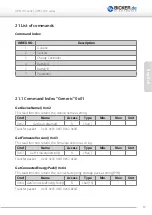
48
English
UPSI-IP-1 series | UPSI- IP-2 series
16 Recommendations for a long UPS service life
Supercaps do not have an actual "End of Life" (EOL). Over time, the capacity decreases
and the ESR (equivalent series resistance) increases. However, EOL is often defined as a
reduction in capacity to 70 % and a doubling of the ESR. An important aspect for the
aging of the EDLCs is the end-of-charge voltage and the operating temperature.
Li-ion batteries also age over time depending on cycles, operating temperature and level
of end-of-charge voltage. The end-of-charge voltages are optimized so that they are at
an optimium between service life and performance.
To extend the lifetime of the system, battery packs should not be placed near sources of
heat. Using the UPS in combination with LiFePO4 batteries always a larger capacity than
actually needed should be selected. The less deep the packs are discharged, the longer
the service life lasts.
17 Maintenance
The UPS contains no serviceable parts. In case of a malfunction the
upstream power source has to be disconnected and cables have to be removed.
18 Disposal
Electric and electronic devices must not be disposed with domestic waste! Dispose the
product according legal regulations at the end of the life time. Li-ion or LiFePO4
storage packs can be disposed of by the manufacturer (Bicker Elektronik).
Supercap packs are allowed in the normal electronic waste.
19 Disclaimer
We, the Bicker Elektronik GmbH, have checked the contents of this document for com-
pliance with the hardware and software described. Nevertheless, deviations can not be
ruled out, so we assume no liability for the complete agreement. The information in this
publication is checked regularly, necessary corrections are included in the updated versions.















































